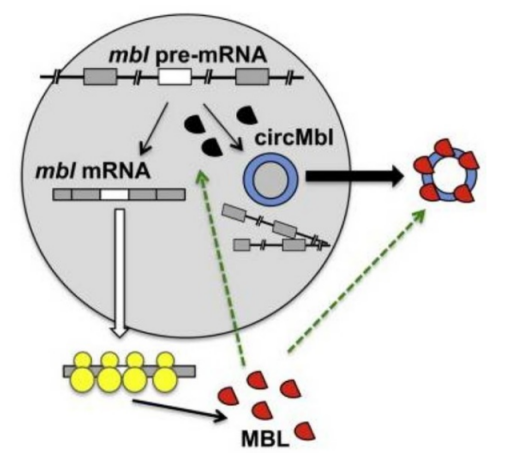miRNA sponge functional model plays a very significant role in biological researches. In this blog, we mainly introduce professor Rajewsky Nikolaus, who have contributed a lot for the circular RNA function study.
Professor Rajewsky Nikolaus currently is a tenured professor in Max Delbruck Institute for Medical Systems Biology in Berlin, an academic leader of Berlin Institute of Medicine, as well as a member of "Wissenschaftskolleg zu Berlin" Academic Advisory Committee, other specific information can be found in his curriculum vitae. Professor Rajewsky Nikolaus contribution in the field of circular RNA research is significant. It is Professor Rajewsky Nikolaus who put forward the miRNA sponge functional model, which is currently the most recognized by academics. In addition, he also contributed a lot to ring-shaped RNA formation mechanism. He found a large amount of circular RNA in the human brain and blood. He also developed circBase database, which means a lot in circular RNA research. What’s more, Professor Rajewsky Nikolaus has many heavyweight contributions in miRNA and other fields of RNA. His contributions in circular RNA are listed here:
- He is the first one who proposed research papers on miRNA Sponge functional model.
In this paper, there are 63 binding sites of miR-7 on CDR1as. And this paper is one of the most authoritative works on RNA. Due to the number of binding sites is so many for miR-7 targeting CDR1as, professor Rajewsky Nikolaus described it with "miRNA Sponge", which is also called the most famous circular RNA functional model. However, professor Rajewsky Nikolaus himself also noted the CDR1as is an extremely special case, most of the circular RNA do not have so many miRNA binding sites. But more representative function model of circular RNA has not yet been proposed in current academic field. Analyzing miRNA binding sites, especially existing on cyclic RNA sequence remains a key issue to explore circular RNA function.
- He proposed the mechanism of circular RNA biogenesis competing with pre-mRNA splicing.
CDR1as and Sry are the most well-known miRNA Sponge molecules, but the rest of circular RNAs do not have so many miRNA binding sites. Therefore, Professor Rajewsky Nikolaus also want to know the exact function of the rest circular RNAs. In this paper, they demonstrated the mechanism of circular RNA biogenesis competing with pre-mRNA splicing. More interesting, in the gene region of MBL, a RNA splicing protein, would form a cyclic RNA molecule after transcription from the second intron (circMbl). Such kind of circular RNA exists in drosophila and human, which can bind MBL protein. If MBL protein is interfered, it will greatly affect the formation of circMbl. 
- He revealed that biogenesis of circular RNA depends on the reverse complementary sequence located in gene intron.
In this paper, by analyzing the corresponding intron sequences of the coding genes, professor Rajewsky Nikolaus found that reverse complement sequences in introns are an important prerequisite for the biogenesis of cyclic RNA. This conclusion coincided with another cyclic RNA biogenesis model depending on reverse Alu elements which has been proved by Professor Lingling Chen and Professor Li Yang. This paper has been regarded as an important document in studying circular RNA.
- He found thata large number of circular RNAs existing in mammalian brain tissues.
Professor Rajewsky Nikolaus found a large number of circular RNA molecules existing in brain tissues by analyzing the expression level of circular RNA. They are sequence-conserved both in mice and humans, even in drosophila. With brain’s development, the expression of circular RNA will increase, especially in the synaptic structure. Expression of circular RNA and corresponding linear RNA are not fully synchronized, but dynamic. Expression of cyclic RNA has a negative correlation with that of RNA processing protein---ADAR1. Knocking down ADAR1 expression can improve that of cyclic RNA. Circular RNAs in mammalian brain tissue are highly conserved.
- He found thata large number of circular RNA molecules existing in bloods.
Professor Rajewsky Nikolaus has ever reported that there are a large number of circular RNAs in brain tissues. They analyzed the circular RNAs in peripheral blood, and found the amount is also large. They identified 4550 and 4105 kinds of circular RNA molecules in two volunteers, respectively. Ratio of cyclization / linear RNA in blood is higher, which indicates that circular RNA in the blood system may have some other potential.
- He established circBase database.
Professor Rajewsky Nikolaus established and maintained circBase database with his team, which is an important tool in circular RNA research. Circular RNA information in the database covered six species, including human, mouse, nematode, drosophila and latimeria coelacanth.
Overall, Professor Rajewsky Nikolaus is a very influential scientist in RNA research. He is meritorious in the study of circular RNA.

